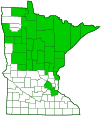hairy honeysuckle
(Lonicera hirsuta)
Conservation • Wetland • Description • Habitat • Ecology • Use • Distribution • Taxonomy
Description |
||
Hairy honeysuckle is a common deciduous vine of the Great Lakes region of North America. It occurs in the United States from Vermont and Connecticut, west to Minnesota and Illinois, and in Canada in Quebec and Ontario. It is common in the northeastern third of Minnesota, where it is at the southwestern extent of its range. It is found in moist woodlands, forest edges and openings, thickets, and swamps. It grows under full or partial sun in sandy or rocky soil. It sometimes creates loose colonies. Hairy honeysuckle is a perennial, deciduous, woody vine that rises on one or more stems from a shallow root system. Mature stems are usually 8′ to 10′ long but can reach 16′ or longer. They climb on adjacent vegetation (twining) or creep along the ground (trailing). When twining, they spiral counter-clockwise, from the lower left to the upper right. When trailing, they produce roots where the stem contacts the ground. The stem detaches at that point, creating a new plant. First year stems and branchlets are greenish and have short, gland-tipped hairs; long, soft, shaggy but unmatted hairs; or a combination of the two. Second year stems are gray, hairless or almost hairless, round in cross-section, and hollow. The mass of spongy cells in the center of the stem (pith), best seen when the stem is sliced at an angle, is round and white. The bark is thin, smooth, and brown or grayish-brown. It peels off in long strips. Winter buds have three overlapping scales. When a leaf drops away, the scar that remains (leaf scar) has three raised areas (bundle scars). The leaves are opposite, stalkless, 1 7⁄16″ to 5⅞″ (3.7 to 15.0 cm) long, and ⅝″ to 3½″ (1.5 to 9.0 cm) wide. The leaf blades are broadly oval, widest in the middle and tapered equally to both ends. They are rounded or tapered at the base and rounded or broadly angled at the tip. The upper surface is dark green and sparsely hairy. The lower surface is pale green, moderately to densely hairy, and covered with a whitish waxy coating (glaucous). The margins are untoothed and have a fringe of long hairs. The uppermost pair of leaves, sometimes the uppermost two pairs, are fused together at the base to form single diamond-shaped to elliptic or round leaves. The inflorescence is a cluster of flowers arranged on 1 to 3 spikes at the end of the stem. The cluster is on a ¼″ to ¾″ (7 to 20 mm) long stalk (peduncle). The peduncle is covered with fine, gland-tipped hairs. Each spike has 1 to 5 whorls, each whorl has 6 stalkless flowers. The flowers are 11⁄16″ to 1 3⁄16″ (18 to 30 mm) long. There are 5 outer floral leaves (sepals), 5 petals, 5 stamens, and 1 style. The sepals are green, about 1⁄32″ (1 mm) long, and are fused at the base. The petals are yellow to orangish-yellow. They are fused at the base and for more than half their length into a narrow floral tube, then separated into two lips. The upper lip is divided into 4 shallow lobes, the lower lip is undivided. The stamens have yellow anthers and protrude well beyond the floral tube. The style has a cap-like tip (stigma) and also protrudes well beyond the floral tube. The flowers appear on the previous season’s stems after the leaves are fully developed and peak from mid-June to mid-July. In Minnesota they are likely pollinated by ruby-throated hummingbirds, butterflies, and moths. The fruit is a soft, globular, 5⁄16″ to ½″ (8 to 13 mm) in diameter berry. It is green initially, becoming orangish-red when ripe. The fruits mature in late July to mid-September, and remain on the plant until picked off by birds or mammals. |
||
Height |
||
Vine: 8′ to 10′ |
||
Flower Color |
||
Yellow to orangish-yellow |
||
Similar Species |
||
| Limber honeysuckle (Lonicera dioica) leaf margins are hairless. The floral tube is also hairless. The flowers are usually purple or red, rarely yellow. | ||
Habitat |
||
Moist. Woodlands, thickets, and swamps. Full or partial sun. Sandy or rocky soil. |
||
Ecology |
||
Flowering |
||
Mid-June to mid-July |
||
Plant Form |
||
Hairy honeysuckle is variously described in the literature as a vine, a shrub, or a “vine or shrub.” A shrub may be described simply as “a woody plant with several stems growing from the base.” By this definition, hairy honeysuckle is a shrub. A vine is usually described as “a plant whose stem requires support and which climbs by tendrils or twining or creeps along the ground.” By this definition, hairy honeysuckle is a vine. |
||
Pests and Diseases |
||
|
||
Use |
||
|
||
Distribution |
||||
|
Sources |
|||
| 2/19/2023 | ||||
Nativity |
||||
Native |
||||
Occurrence |
||||
Common |
||||
Taxonomy |
|||
| Kingdom | Plantae (Plants) | ||
| Division | Tracheophyta (Vascular Plants) | ||
| Subdivision | Spermatophytina (Seed Plants) | ||
| Class | Magnoliopsida (Dicots) | ||
| Subclass | Caryophyllidae | ||
Order |
Dipsacales (honeysuckles, moschatels, and allies) | ||
Family |
Caprifoliaceae (honeysuckle) | ||
| Subfamily | Caprifolioideae | ||
Genus |
Lonicera (honeysuckles) | ||
| Subgenus | Caprifolium | ||
Subordinate Taxa |
|||
|
|||
Synonyms |
|||
Lonicera hirsuta var. interior Lonicera hirsuta var. schindleri |
|||
Common Names |
|||
hairy honeysuckle |
|||
Glossary
Bundle scar
Tiny raised area within a leaf scar, formed from the broken end of a vascular bundle.
Elliptic
Narrowly oval, broadest at the middle, narrower at both ends, with the ends being equal.
Glaucous
Pale green or bluish gray due to a whitish, powdery or waxy film, as on a plum or a grape.
Peduncle
In angiosperms, the stalk of a single flower or a flower cluster; in club mosses, the stalk of a strobilus or a group of strobili.
Pith
The spongy cells in the center of the stem.
Stigma
In plants, the portion of the female part of the flower that is receptive to pollen. In Lepidoptera, an area of specialized scent scales on the forewing of some skippers, hairstreaks, and moths. In Odonata, a thickened, dark or opaque cell near the tip of the wing on the leading edge.
Trailing
Prostrate on the ground and creeping, but not rooting at the tip.
Twining
Growing in a spiral usually around a stem of another plant that serves as support.
Visitor Photos |
|||||
Share your photo of this plant. |
|||||
| This button not working for you? Simply email us at info@MinnesotaSeasons.com. Attach one or more photos and, if you like, a caption. |
|||||
Luciearl |
|||||
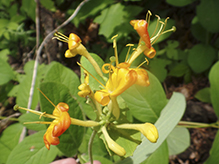 |
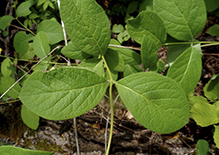 |
||||
MinnesotaSeasons.com Photos |
|||||
Plant |
|||||
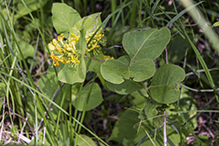 |
|||||
Inflorescence |
|||||
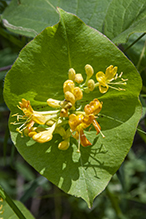 |
|||||
Flowers |
|||||
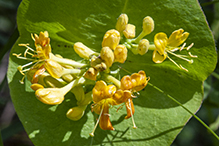 |
|||||

Slideshows |
||

Visitor Videos |
|||
Share your video of this plant. |
|||
| This button not working for you? Simply email us at info@MinnesotaSeasons.com. Attach a video, a YouTube link, or a cloud storage link. |
|||
Other Videos |
|||

Created: 1/26/2020
Last Updated:
